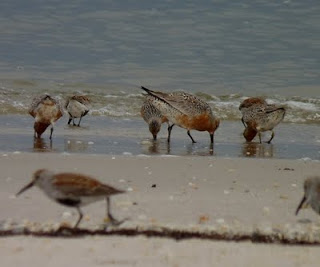 |
| Red Knots and Dunlin feed together at Reeds Beach |
What additional protections result from a listing remain to be seen, but conservationists have some suggestions:
Advocates say the listing would help not only the red knot, but many other shorebird species that migrate through Delaware Bay and are in a similar, although less dire, decline. These would include the ruddy turnstone, semi-palmated sandpiper and sanderling....I wrote about the study connecting Red Knots to Delaware Bay stopover habitat last week.
During the 1980s and '90s, peak Delaware Bay counts of the red knot reached 95,000. Since 2004, they ahve been consistently below 16,000. Likewise, in their wintering area at the tip of South America, peak counts have dropped from 75,000 to 16,260 in 2010. At the winter count earlier this year, the number had declined to less than 10,000.
Meanwhile, a recent study by New Jersey biologist Larry Niles, who has followed the bird to the ends of the earth in a decade or more of study, and others has confirmed the key role that horseshoe crab eggs play.
"Right now, we need to see more adult crabs breeding, and we're not," Niles said. Fisheries officials that govern the crab harvest keep saying to give it more time, he said. "That would be fine, except we were promised signs of recovery six years ago."
He suspects further restrictions in the harvest are needed. Or the problem now may lie elsewhere. The illegal harvet may be greater than estimated. The blood of the crab is used as an indicator for contamination in medical devices, and the crabs are caught, partially bled and then returned to the wild. But a recent study suggested that mortality from this may be higher than estimated.
Habitat protections might also result, though a lot of the Red Knot's habitat falls outside of the U.S. – in Canada for breeding and in southern South America for wintering. Either way, it is a positive step forward, and I hope it results in a stronger Red Knot population.



